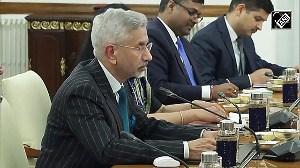In the last few years, as modern retail concepts begin to make an appearance across urban India, the debate on their impact on the traditional Indian retail businesses including the so-described "mom & pop" stores and the neighbourhood kirana stores gets shriller.
Those against opening the Indian market to foreign direct investment in the retail sector use a barrage of arguments but the most superficially potent one is the likely negative impact on the livelihood of the millions, currently eking a living from their small retail businesses.
Even the most ardent supporters of liberalisation in this sector become a bit uneasy when faced with the prospect of their causing misery to their fellow citizens.
Is this really the way it will pan out in the Indian context when it comes to the fight for the share of customer spending between the presumably powerful modern retailers and the helpless, small traditional ones?
Wal-Mart gets ready to enter India
Will the (certain) growth of organised retailers across urban and rural India lead to massive unemployment over the next 10 years?
My company recently attempted to address this question in an objective, scientific, analytical way and after an effort spread over six months; 24 pan-India markets covering small, medium, and large urban and rural centres; and more than a thousand retailers and distributors of all sizes, and then using this mountain of information to develop different models and scenarios in order to come out with some predictions for what the composition of various forms of retail channels will be in India in the next five years (2011) including the paan shops, kirana stores, supermarkets, chemists, general merchants, etc.
Is the news good or bad? Defying naysayers, and supporting the minority that has consistently propagated that modernised retail will not lead to any significant disruption or unemployment almost anywhere in India, the results indicate that in top towns (population above 1 million), within the next 10 years, the total population of retail outlets will actually substantially increase from the current estimate of about 0.68 million to 1.29 million.
India, soon a shoppers' paradise
In towns with populations between 50,000 and 100,000, the increase will be from 0.84 million to 1.58 million.
In towns smaller than a population of 50,000 and neighbouring rural clusters, the increase will be from 5.6 million outlets to 9.5 million!
Even more interestingly, this change is in the most aggressive of all scenarios of investment in the modern retail over the next five years. In this scenario, investments of over Rs 50,000 crore (RS 500 billion) have been factored in, leading to a size of modern retail touching Rs 200,000 crore (Rs 2000 billion) by 2011 itself.
Under more conservative (alternative) scenarios, the growth in the number of so-called "traditional" retail channels is even more pronounced.
Of course, from the perspective of consumer product companies, there is a pronounced shift in the share of shelf-space across various types of channels and hence their marketing/branding strategies will have to be suitably modified, but that will be the subject of a future column.
Why are these findings so counter-intuitive? In a way, these are actually intuitive. The key lies in the very basic appreciation of the fact that the Indian consumer spending has been rising at almost 7-8 per cent per year for the last 8-10 years.
There is no reason to believe that any slowdown in this spending is in the offing, especially when consumer incomes are being supplemented with a steady, rapid rise in consumer credit.
From the current level of about Rs 11,50,000 crore {Rs 11500 billion (spent through conventional "retail" channels)}, the overall level of consumer spending is likely to rise to over Rs 18,00,000 crore (Rs 18000 billion) by 2011.
Hence, even if the modern retail businesses account for Rs 200,000 crore (Rs 2000 billion) of the consumer spending, the additional value that will be spent through traditional retail channels will exceed Rs 450,000 crore (Rs 4500 billion) within the next 5-6 years or an increase of almost 30 per cent from the current level of consumer spending through traditional retail channels in 2005.
Of course, it is very likely that retail businesses falling in very close proximity of large hypermarkets and supermarkets may get impacted negatively. However, it is very unlikely that even by 2015, India will see more than 2,500 hypermarkets and 5,000 supermarkets on account of various constraints including availability of financial resources, land, and related infrastructure.
Hence, the actual numbers of those impacted directly by the arrival of such hypermarkets and supermarkets will be a very small proportion of the total universe of traditional retail outlets across the length and breadth of India.
My company is, of course, continuing to refine this model to make it even more robust and add more complexity but versatility, even while ironing out some discrepancies. The final numbers may change somewhat but directionally, I believe that these projections are an accurate reflection of the likely trends over the next 10 years.
My conclusion would be that it is high time the government of India articulated a clear strategy and policy for the internal trade activity in India. It is far too important an element of the overall economic policy for the nation to be left to the misguided perceptions of a few political parties or to the vested interests of the few who benefit from current state of confusion!
The author is chairman, KSA-Technopak India.






